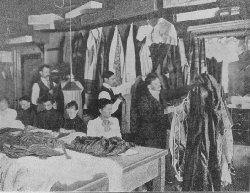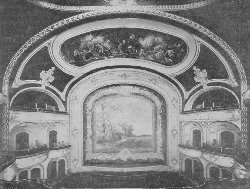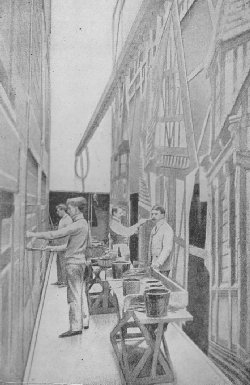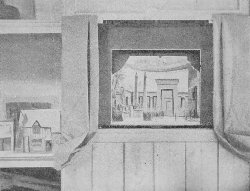A BIG CLOCK
On the House of Parliament in London is a clock, the striking part of which takes one-half a day to wind up. The clock has four dials-one on each side of the square tower. See illustration on page 332 of this book.
HOW THE MODERN THEATER IS CONDUCTED
HOW MUSIC IS PRINTED
Table of Contents
Return to Main Page
© 1998, 2002 by Lynn Waterman
HOW THE MODERN THEATER IS CONDUCTED
Something of the glamour of romance and mystery veils the world behind the footlights to those who have never lived within that mystic circle, but the life is anything but romantic and mysterious to the players and the workers.
THE THEATER WORKHOUSE.
 | | Where costumes are made. |
On the contrary, while to the public a theater is a playhouse, it is, to those connected with it, something of a workhouse. Either a mental or physical effort is required almost every minute of one's working hours. The ceaseless routine of duties necessary to the completion of each production commences at the desk of the manager, who reads the manuscripts of countless plays, and selects the one he thinks will most please the public.
THE MANAGER'S SELECTION OF A PLAY.
These manuscripts are obtained either from the playwright direct, or from the playwright's agent. Accompanying each manuscript is a statement of the royalty to be paid for the plays used. This right of royalty sometimes costs the manager as much as $1,000 a week. There are plays that cost even more than that; but the average cost is about $500 per week.
THE STAGE DIRECTOR'S PREPARATIONS.
 | By courtesy of Geo. R. Lawrence, Chicago
View showing proscenium and box
arrangement of a modern theater.
Illinois Theater, Chicago. |
After the manager has selected a play to follow any given production, the manuscripts go immediately to the stage director, who is the power behind the throne (footlights), and the autocrat of the world on and beneath the stage. It is his province to direct, and his duty to apportion, the various tasks involved in the mechanical construction and the mental preparation of a play.
After having read the manuscript the stage director begins "to plot," not like the villain in the play, but with pencil and paper. Using those business materials, he draws the scene plot, and several other minor plots, varying in number and importance according to the extent of the production.
THE SCENIC ARTIST, PROPERTY MAN ELECTRICIAN AND STAGE CARPENTER.
This finished, he turns over the scene plot to the scenic artist, who immediately wrinkles his brows for an imaginative conception of an original interior or a fresh landscape. The stage director assigns the property plot to the property man, who begins to get the hundred and one articles that are to be a part of the coming production. The light plot goes to the electrician, who at once begins planning the light effects for this particular play. Still another plot goes to the stage carpenter, who at once sets about with saw, hammer and nails to make such frames as are necessary.
THE ORCHESTRA LEADER.
The "plotting" does not end here, for, the leader of the orchestra, whose duty it is to select the proper character of music for each situation—something tremulous, for the tears, something lively, for laughter, and something heroic for the melodramatic, is given a "plot."
ASSIGNMENT OF PARTS.
 | By courtesy of the columbia Theater, Chicago.
Where scenery is painted. |
These plots having been formed and distributed, the stage manager then proceeds to
cast the play—that is, he mentally canvasses the individual talents of the members of the company and assigns to each one the part most suited to that person. Sometimes a player possesses sufficient versatility to fill any role, but such versatility is rare. Good judgment in assigning the parts is therefore an indispensable attribute of a good stage manager.
Not every player, to be sure, is invariably assigned to the part he would most like to play, but the part he would most like to play is not always the part he could play best. As to that, the stage director is the judge, and upon the correctness of his judgment frequently depends the success of the production.
UP IN THE "FLIES."
While the property man goes about the getting together of the "props" the scenic artists high up in the flies are busily working upon the scenery for the coming production. The paints are "cooked" and the colors blended upon such canvases as are to be used. For each production there is an entirely new outfit, giving a freshness of scenic investiture to each play that is practically impossible with traveling organizations.
MODERN FEATURES IN STAGE PRODUCTION.
 | By courtesy of the Columbia Theater, Chicago.
Model for stage scene. |
In producing plays at the present time nothing is impossible. Lightning is made to go zig-zag across the stage at the will of the electrician, miniature lakes and fountains are the work of the stage carpenter and manager, and, in fact, so far advanced are the methods of the modern stage that a locomotive may be made to appear as if going through flames at a terrific rate of speed, while in fact it is absolutely stationary. Flame is often made with cloth and colored lights. Steam is made to take the place of smoke. The ear, too, is deceived as well as the eye, and thus the most realistic effects are achieved.
All this varied and elaborate procedure involves a large expenditure, which finds its return, with a very handsome margin of profit, in the patronage received from the theater loving public. The popular tendency to crowd before the footlights never seems to diminish, and if the plays are of the proper character, the amusement and edification obtained from witnessing histrionic productions constitute a wholesome diversion.
HOW LIQUORS ARE DISTILLED
A BIG CLOCK
Table of Contents
Return to Main Page
© 1998, 2002 by Lynn Waterman
|



